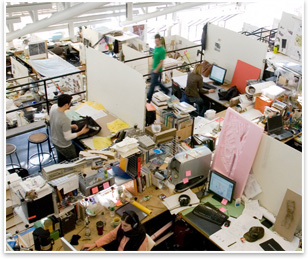Harvard Graduate School of Design Concentrates on Sustainability
New degree concentration pushes eco-friendly design forward
by Zach Mortice
Associate Editor
 Summary: The Harvard Graduate School of Design’s new sustainable design concentration area exposes students to building and urban-scale eco-friendly design strategies. It also promotes the adoption of energy modeling-based sustainability certification metrics. The program hopes to help remove perceived barriers between quality design and sustainable building practices. Summary: The Harvard Graduate School of Design’s new sustainable design concentration area exposes students to building and urban-scale eco-friendly design strategies. It also promotes the adoption of energy modeling-based sustainability certification metrics. The program hopes to help remove perceived barriers between quality design and sustainable building practices.
A new sustainable design concentration area at Harvard Graduate School of Design is asking tough questions about the future and format of sustainable design. As part of the school’s master of design studies program, the new concentration is coordinated by Associate Professor of Architectural Technology Christoph Reinhart. The program, beginning this fall, has been in the works for a year and consists of four prerequisite classes on daylighting, building performance simulations, sustainability, and independent research.
Because it’s so new, students haven’t had a chance formally to sign up for it yet, but several students’ work and research already aligns with this emphasis on sustainability. The program’s curriculum looks at a broad range of building-scale sustainability strategies (daylighting, green roofs, automated controls), as well as urban-scale issues like water management, traffic and infrastructure, and brownfield recovery.
“You can’t isolate building performance from its urban context,” says professor Martin Bechthold, the co-director of the sustainability concentration. He teaches classes in building technology and digital fabrication. “Site, prevailing winds, urban heat islands—they always impact building performance.”
“I think what we are currently still having to work on is how we get from our really detailed analysis at the building level to an analysis that looks at neighborhoods,” says Reinhart. “That’s where research and practice are still meeting.”
Other colleges and universities have also added green and sustainability degree programs in recent years, from design programs to sustainability MBAs. Brandeis University and Colorado State University now offer green-oriented MBA coursework. The University of Minnesota’s architecture school now offers a master of science in sustainable design.
Graduating from prescriptive sustainability ratings
Both Reinhart and Bechthold see it as their job to teach students how to critique and revise the current profusion of sustainability rating and certification systems, such as the USGBC’s LEED® (which they see as a good first attempt at codifying green design, though far from definitive) or the Green Building Initiative’s Green Globes.
For them, this means moving beyond prescriptive ideas of what a green building is towards energy performance-tested and modeled building metrics where the impact of each feature and material’s effect on energy, consumed and embodied, is known. “The idea is to move towards a more evidence-based architecture where a designer wouldn’t speak about sustainability in abstract terms,” says Reinhart. “I push students to prove to me and themselves that what they’ve done is really better. LEED looks at ASHRAE-based concepts of comparing an imaginary reference building to the actual building. Why don’t we look at the absolute numbers—the real footprint of the building?”
ADDING VALUE TO AIA MEMBERSHIP
The AIA’s stake in teaching sustainability
The AIA Educator/Practitioner Network is organizing a three-day summit in November for architects and collegiate educators interested in sustainability and carbon neutral design. The Carbon Neutral Design conference will bring architects and college professors together to sort through sustainable building case studies in the hopes of crafting teaching tools for other educators and architects, according to the AIA’s director of education, Catherine Roussel, AIA. The resulting materials will appear on the AIA’s Web site, as well as through academic channels.
Other recent AIA initiatives to bring architects and educators together in advancing the agenda of a sustainable built environment have included a 2007 conference in Pomona, Calif., that gathered input from architects and college professors about the general direction that sustainable architecture education should take, and a 2006 study gauging ecological literacy in architecture education.
Students of the sustainability concentration will be looking at the real energy footprint of their own building, the Modernist George Gund Hall, home to the Graduate School of Design, built in 1968 and designed by John Andrews, Hon. FAIA. They’ll be examining (in a class taught by Reinhart) its use and energy performance patterns, which will then be tied to a campus-wide renovation project, ensuring that their work becomes more than an academic exercise.
Reinhart and Bechthold are also encouraging an appropriately interdisciplinary approach to the broad application of sustainability in the built environment, as the sustainable design concentration is applicable to other concentration areas, like real estate project management and urbanization and housing studies. The professors are also encouraging students to get public health perspectives on sustainability at Harvard’s School of Public Health.
Learning to have it all
Considering the design pedigree of the Harvard Graduate School of Design, by embracing sustainability the students and faculty are uniquely positioned to help tear down walls between architecture of uncompromising quality and sustainable building practices. Reinhart says that architects can and should expect to attain both pleasing aesthetics and sustainable designs, and that the limitations placed on architects interested in sustainable design should be regarded just as any other context or constraint, like the unavailability of a certain building material or a site with poor street access.
“The notion that there’s always a conflict is a little passé,” he says.
As the sustainable design field deepens and broadens, new technologies and materials give architects more and more options beyond the narrow “pitched green roof” aesthetic, as Bechthold calls it, which dominated early ideas of green building.
“How we go about merging those and synergizing between [design and sustainability]—that’s one of the questions we’re interested in exploring,” says Bechthold.
| 

 Summary:
Summary: